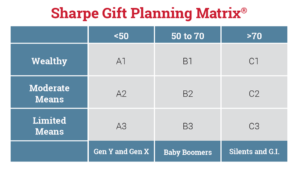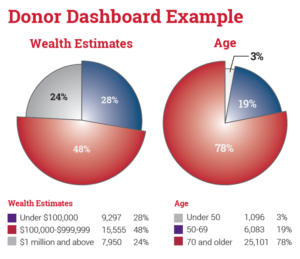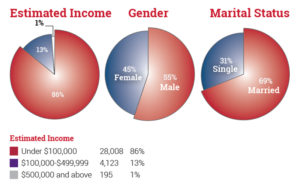Knowing the age and wealth of your donors can make a huge difference in how, when and what you communicate with them.
Imagine having the information you need to master your marketing efforts. Think how effectively you could allocate your budget if you knew precisely how and when to communicate with your donors for maximum fundraising effectiveness. It’s not just a dream. The Sharpe Gift Planning Matrix® is a data-driven tool that provides a demographically enhanced and segmented donor database you and your staff can use to strategically segment your marketing and communications efforts for optimal results.
How it works
The Gift Planning Matrix recognizes demographic and economic lifecycle factors and segments your donor file into nine specific categories based on age and wealth. The Matrix codes are then applied to your database to allow more targeted fundraising approaches based on generational cohort grouping and economic capacity— according to both income and wealth. This enables you to determine what types of gifts are most likely to be attractive within specific age groups and giving capacity levels.
For example, IRA gift prospects for large qualified charitable distributions (QCDs) between $10,000 and $100,000 per year would be classified as C1s. The best IRA gift prospects for QCDs between $1,000 and $9,999 would tend to be C2s, and the C3s would generally be prospects for smaller IRA distributions under $1,000.
Other gift plans, such as lead trusts, remainder trusts, gifts of securities or life estates tend to have a more wealth-oriented profile. Seven-figure bequests will only come from estates in excess of a million dollars, for example. Taxpayers with higher income levels are more likely to benefit from itemized deductions and be in the upper income tax brackets.
How your donors fit in the Matrix
Based on your enhanced constituency file data, Sharpe will construct your custom Gift Planning Matrix. It begins with an analysis of your file based on age compared to live births in America.
Then, we consider giving capacity based on wealth or income levels and combine them to generate one of the nine basic Matrix codes in which every member of your constituency will be identified. These codes will help you visualize your database to plan and budget marketing and communications more effectively, whether assigning individual donor portfolios or targeting direct marketing through various print and digital channels.
Your Donor Dashboard
In addition to the Gift Planning Matrix, your enhanced data file provides you and other members of your team with a number of specific gauges to create a “Donor Dashboard” to better understand your overall constituents based on a donor’s age, gender, marital status and estimated income and wealth in a number of ranges up to $2 million+.
By combining age, wealth, giving history and other demographic information, you can use the Gift Planning Matrix to effectively reach the right people in your file at the right time in their lives, with the right communications to help them consider the right gifts for them to make.
Your unique Donor Dashboard can be combined with traditional giving metrics (recency, frequency, monetary amount) and Matrix codes to make data-driven decisions for more effective fundraising results.
Click here for more information about SHARPE newkirk’s Donor Data Enhancement Services and the Gift Planning Matrix or contact us at info@SHARPEnet.com or 901.680.5300.





